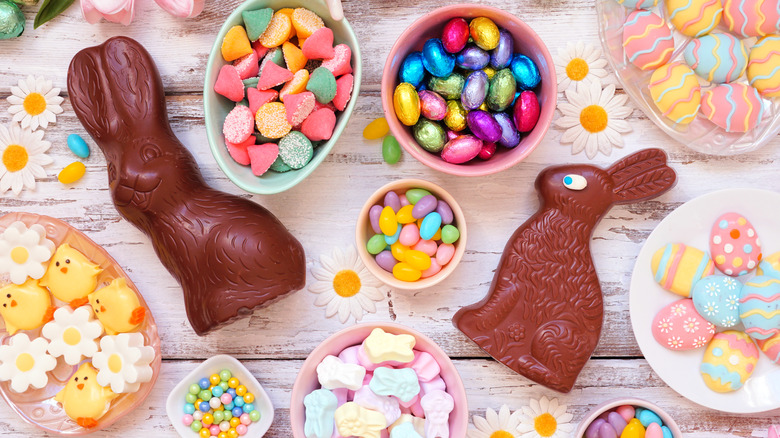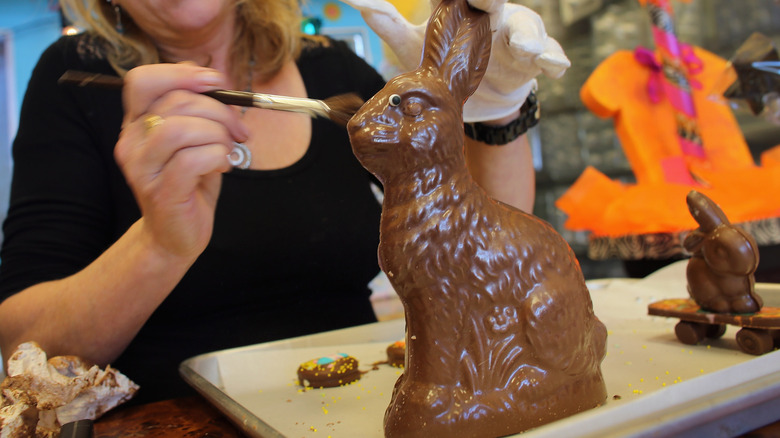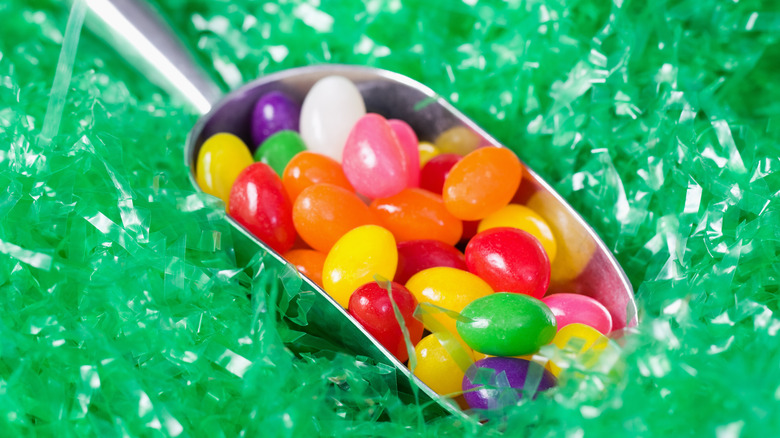Where Did The Tradition Of Easter Candy Originate?
One of the passages of spring is walking into the candy aisle at your favorite store and seeing the large selection of pastel-colored marshmallow treats, rainbow-hued jellybeans, and a vast array of eggs and bunnies made from white, dark, and milk chocolates. It's just like Halloween — but in prettier colors! How did this holiday, an important religious celebration for Christians around the world, become one of the four biggest annual occasions for candy purchases? The answer isn't quite clear, but a look at the history of some of the most popular Easter candies and traditions gives us some clues.
To understand why shoppers spent $5.4 billion dollars on Easter candy in 2024, it's important to first understand how Easter became associated with eggs, bunnies, and baskets. You won't find eggs or bunnies in the New Testament but, as symbols of fertility and new life, they hew closely to the themes of the day set aside to celebrate Jesus' resurrection.
The origin of baskets is a little murkier. Some say they are a nod to the Anglo-Saxon goddess of spring and fertility, Eostre, who was depicted holding a woven basket. Others say baskets evolved from the nests left by parents so the Easter bunny could "hide" eggs for their children. They may also be based on the tradition of bringing baskets filled with seedlings to the church where they could be blessed in the hopes of a successful harvest. Regardless of the explanation, once there were baskets to be filled, candy was one way to fill them.
German traditions carry over to American celebrations
One of the first chocolate confections to fill those baskets was the chocolate bunny, a tradition thought to be German in origin. Germans had celebrated Ostara, the ancient goddess of spring, herself a symbol of renewal and fertility. According to legend, Ostara turned a wounded bird into a rabbit in order to save its life. The rabbit retained the bird's ability to lay eggs and, to thank Ostara, decorated and gifted her the eggs. The rabbit eventually became known as Osterhase — a folkloric figure Germans brought with them when they settled in the United States, particularly in Pennsylvania, during the 18th century.
The Osterhase tale was eventually woven into Easter celebrations. In either the late 19th or early 20th century, chocolatiers celebrated Osterhase by creating hollow chocolate stand-ins using newly developed molding techniques. The chocolate treats became widely coveted after a Pennsylvania drug-store owner named Robert L. Strohecker placed a 5-foot-tall chocolate rabbit in his store window.
The Germans who settled in what is now known as Pennsylvania Dutch country may have also played a role in the history of Peeps, the perennial Easter favorite. The bright yellow, sugary marshmallow confections were first made by the Rodda Company, which was based in Lancaster, Pennsylvania. One version of the tale says Rodda created candy shaped like bunnies, eggs, and crosses to boost sales to its German neighbors, often using marshmallow. The same version says the marshmallow chicks came later, when they were custom ordered in the 1940s, a laborious task since one tray took 27 hours to prepare. The Just Born company, a nearby manufacturer, acquired Rodda in the 1950s and used its automated manufacturing processes to mass produce Peeps. Some estimates say 700 million Peeps are sold each year, 70% of which are sold during Easter.
Jelly beans enter the stage as a gift for soldiers
Unlike Peeps, jelly beans did not originate as an Easter treat. The tiny beads of jelly were widely believed to have been invented by Boston-based candymaker William Schrafft in the mid-1800s. Shrafft molded jelly — which some accounts say was actually the same recipe used for the ancient sweet Turkish delight — into bean shapes and added a hard sugar shell. He encouraged customers to give the beans as gifts to soldiers serving in the Civil War. Jelly beans became an Easter staple in the 1930s. One food historian told Boston radio station WBUR that this was when bakers started using the candy to decorate their cakes. People also took note of their egg-like shape and started to include them in their Easter celebrations.
Jelly beans, however, are not the top-selling candy during Easter. Although the National Confectioners Association says 62 million packs of jelly beans were sold in 2024, its ranking of holiday treats shows 44% of Americans favor chocolate eggs and bunnies, followed by jelly beans, candy-coated eggs, and marshmallow candy. In its report on Easter and Passover sales, Instacart predicts that chocolate will fill the five top spots on its list of the most popular Easter candies. The online retailer projects Reese's Peanut Butter Eggs as the top seller. Perhaps their popularity explains why Reese's introduced a snack-sized version, mini peanut butter eggs, in 2024.


